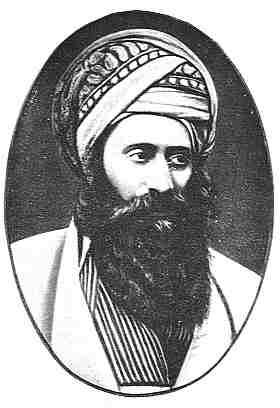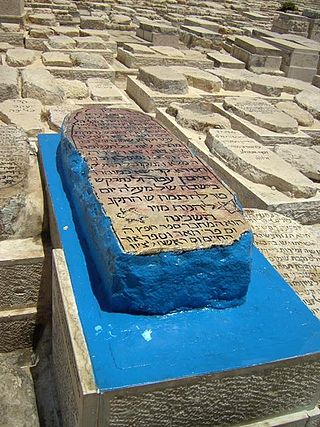Related Research Articles
Samaritan Hebrew is a reading tradition used liturgically by the Samaritans for reading the Ancient Hebrew language of the Samaritan Pentateuch, in contrast to Tiberian Hebrew among the Jewish people.

Yosef Hayim was a leading Baghdadi hakham, authority on halakha, and Master Kabbalist. He is best known as author of the work on halakhaBen Ish Ḥai, a collection of the laws of everyday life interspersed with mystical insights and customs, addressed to the masses and arranged by the weekly Torah portion.

A Mikraot Gedolot, often called a "Rabbinic Bible" in English, is an edition of the Hebrew Bible that generally includes three distinct elements:
Aaron ben Elijah is often considered to be the most prominent Karaite Jewish theologian. He is referred to as "the Younger" to distinguish him from Aaron ben Joseph of Constantinople. Even though Aaron lived for much of his life in Constantinople, it was the centre of Karaism and he is sometimes distinguished from another theologian known as Aaron ben Elijah of Constantinople by the title "of Nicomedia" another place he lived.

Hayyim ben Joseph Vital Calabrese/Calabris was a rabbi in Safed and the foremost disciple of Isaac Luria. He recorded much of his master's teachings. After Vital's death, his writings began to spread and led to a "powerful impact on various circles throughout the Jewish world."

Chaim ibn Attar or Ḥayyim ben Moshe ibn Attar also known as the Or ha-Ḥayyim after his popular commentary on the Torah, was a Talmudist and Kabbalist. He is arguably considered to be one of the most prominent Rabbis of Morocco, and is highly regarded in Hassidic Judaism.
Aaron ben Jacob ha-Kohen was one of the hachmei Provence, one of a family of scholars living at Narbonne, France, who suffered from The Great Exile of 1306.
Alfandari was a family of eastern rabbis prominent in the 17th and 18th centuries, found in Smyrna, Constantinople, and Jerusalem. The name may be derived from a Spanish locality, perhaps from Alfambra. The following is a list of the chief members of the family:
Hayyim ben Jacob Alfandari was a talmudic educator and writer, teaching at Constantinople in 1618. He was the pupil of Aaron ben Joseph Sason. Some of his responsa were published in the Maggid me-Reshit, Constantinople, 1710, which contains also the responsa of his son Isaac Raphael, and which was edited by his grandson Hayyim ben Isaac Raphael. His novellæ on several Talmudic treatises are still extant in manuscript.
Kol Bo is a collection of Jewish ritual and civil laws. Its author has not yet been ascertained. The work in content resembles other codes, as, for instance, the Orḥot Ḥayyim, though in its form it is very different.
Ben Haim, also transliterated as Ben-Haim, Ben Hayim, Ben Hayyim and Ben-Chaim, is a Hebrew surname meaning "son of life". Notable people with the surname include:

Ḥayyim Selig ben Ya'akov Slonimski, also known by his acronym ḤaZaS, was a Hebrew publisher, mathematician, astronomer, inventor, science writer, and rabbi. He was among the first to write books on science for a broad Jewish audience, and was the founder of Ha-Tsfira, the first Hebrew-language newspaper with an emphasis on the sciences.

A meshulach, also known as a shaliach or SHaDaR, was an emissary sent to the Diaspora to raise funds (ḥalukka) for the existence of the Jewish settlement in the Land of Israel. The institution of the Emissaries of the Land of Israel, which began in ancient times, developed and contributed greatly to the connection between Diaspora Judaism and the Jews in the Land of Israel, and to the cultural life of the Jewish communities.
Aaron Cupino was a talmudist and head of a yeshiva at Constantinople, who flourished about the close of the 17th-century.
Aaron ben David Cohen of Ragusa was a Rabbi in the Republic of Ragusa.
Aaron ben Isaac Sason was an Ottoman author and Talmudist; born in Constantinople in 1629. He was a grandson of Aaron ben Joseph Sason, an eminent Talmudist, and cousin of Ḥayyim Benveniste, the famous scholar. Aaron Cupino, rabbi of Constantinople, was his teacher in Talmudic lore, and was so successful that at the age of twenty his pupil engaged in Talmudic controversies with Moses Benveniste, who thought them worthy of publication. A Palestinian commentator Judah Rozanes referred with respect to an unpublished work, "Hen Yeshallaḥ," by R. Aaron. Whether the work "Sefat Emet" should be credited to R. Aaron or to his grandfather, Aaron ben Joseph, is uncertain. The latter is more probably its author. Shabbethai Bass, the only writer who mentions that particular book, in his "Sifte Yeshenim," throws no light on this question, merely mentioning that it is by Aaron Sason.
Aaron ha-Levi Oettingen was a Galician rabbi; born about the beginning of the eighteenth century; died in Lemberg about 1769. He was one of a prominent family of rabbis, and officiated for the congregations of Javorov and Rzeszow. His father, Ḥayyim Judah Loeb ben Eliezer, was rabbi of Lemberg, as was also his father-in-law, Ḥayyim Cohen Rapoport, author of responsa, ultimately published at Lemberg, 1861. Aaron strongly opposed the Ḥasidism which arose in Galicia, and especially attacked Elimelech of Lezaysk, the author of "No'am Elimelech". His approbations are found in various works of that period.
Aaron Moses ben Mordecai was one of the few cabalistic writers of East Prussia: author of a work, "Nishmat Shelomoh Mordecai", so called in remembrance of his son, who died in early childhood. On the title-page the statement is made that the work is a commentary on M. Ḥ. Luzzatto's "Ḥoḳer u-Meḳubbal"; indeed the text of this treatise is printed in the volume. Aaron used the name of Luzzatto merely to give greater vogue to his own book, because of the waning influence of the Cabala in Poland at the time. In reality, Aaron's work is a commentary on the "'Eẓ Ḥayyim" of Ḥayyim Vital, the arch-apostle of the cabalistic school of Luria. Aaron Moses states that he was the author also of a commentary on the Midrash Tanḥuma, entitled "Zebed Ṭob". This has not been printed.
Isaac of Ourville was a medieval French rabbi, author of the mostly-lost SeferhaMenahel, a book of halakha.

Ḥayyim ben Shabbethai, commonly known by the acronym Maharhash was a Sephardic rabbi and Talmudist, who is considered to be one of the great sages of Greek Jewry, serving as the Chief Rabbi of Thessaloniki, Greece.
References
 This article incorporates text from a publication now in the public domain: Singer, Isidore; et al., eds. (1901–1906). "Aaron ben Hayyim". The Jewish Encyclopedia . New York: Funk & Wagnalls.
This article incorporates text from a publication now in the public domain: Singer, Isidore; et al., eds. (1901–1906). "Aaron ben Hayyim". The Jewish Encyclopedia . New York: Funk & Wagnalls.